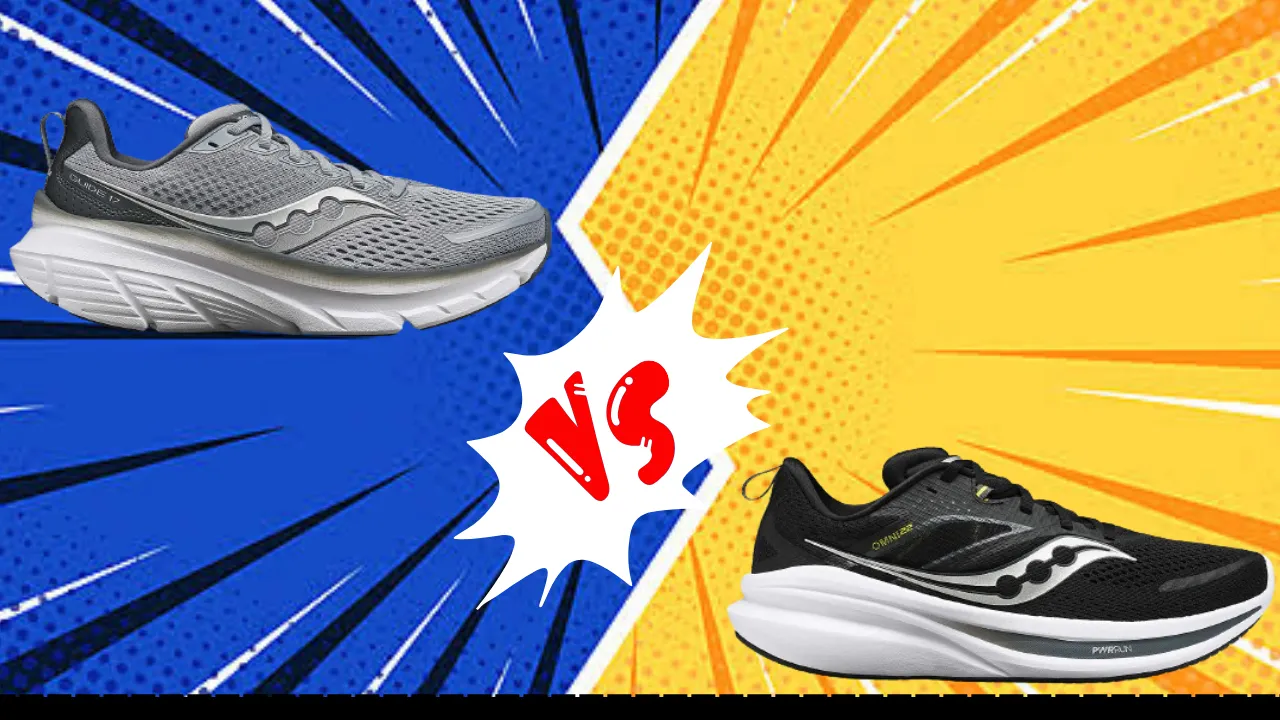If you’re a runner who overpronates, you may be debating between the Saucony Guide 17 and Saucony Omni 22 stability running shoes. Both are designed to provide support and stability for overpronators, but they have key differences that may make one better suited for your needs. This in-depth comparison breaks down the specs, features, and performance of each shoe.
Similarities And Differences Between Saucony Guide 17 And Omni 22:
| Feature | Saucony Guide 17 | Saucony Omni 22 |
|---|---|---|
| Launched In | 2024 | 2024 |
| Stability | Moderate | Maximum |
| Flexibility | Moderate | Moderate |
| Sizing | Men’s 7-13, Women’s 5.5-12 | Men’s 7-13 |
| Weight | 10.6 oz (M), 9.2 oz (W) | 10.1 oz (M) |
| Cushioning | PWRRUN | PWRRUN |
| Outsole | XT-900 rubber | XT-900 rubber |
| Midsole | PWRRUN+ | PWRRUN |
| Upper | Engineered mesh | Engineered mesh |
| Retail Price | $140 | $140 |
Features Comparison:
Materials:
The Saucony Guide 17 uses a PWRRUN+ midsole foam which provides a soft, responsive ride. The engineered mesh upper is breathable, flexible, and sock-like against the foot.
It adapts to the shape of your foot for a customized fit. The outsole uses durable XT-900 carbon rubber in high-wear areas for enhanced traction and longevity, letting runners comfortably rack up the miles.


In contrast, the Saucony Omni 22 utilizes a single-density PWRRUN midsole foam which is a bit firmer and denser. It also has an engineered mesh upper and XT-900 rubber outsole but these are slightly lower-grade materials compared to the Guide 17. Overall, Guide 17 wins out in terms of premium material construction.
Durability:
Both the Guide 17 and Omni 22 shoes use high-quality materials like engineered mesh uppers and durable carbon rubber outsoles, so they should prove quite durable and long-lasting for many miles of running without breaking down.
The Guide 17 may have a slight edge in longevity thanks to its PWRRUN+ midsole foam versus the standard PWRRUN foam used in the Omni 22. But both shoes are solidly constructed with premium components designed to go the distance as daily training companions for the dedicated runner. You can’t go wrong with either in terms of durability.
Fit:
The Saucony Guide 17 runs true to size for most runners, with a comfortably snug heel hold and medium volume forefoot room to accommodate slight swelling that occurs when running long distances. The engineered mesh upper is very flexible, moving naturally with your foot for a sock-like fit.


The Omni 22 has a similar true-to-size fit through the midfoot and heel, but testers found it runs noticeably narrower than the Guide 17 in the toe box area. This can pinch toes and feel restrictive for runners with wider feet.
Value for Money:
With both shoes retailing at around $140, you get a lot for your money with either the Saucony Guide 17 or Omni 22. The Guide 17 provides a soft, flexible ride with quality cushioning and a breathable upper, making it a great value for moderate overpronators.
The Omni 22 packs in maximum stability and support features like a dual-density midsole and firm medial post to prevent excess rolling, delivering excellent value for severe overpronators needing that extra motion control in an affordable package. No matter your stability needs, both give you premium features and durable construction at a very reasonable price point.
Performance Comparision:
Walking:
The Guide 17’s plush PWRRUN+ midsole foam provides a much softer, bouncier feel underfoot that makes walking in the shoe very comfortable over long distances. Its moderate stability features keep your foot properly aligned when walking without being overly rigid or restrictive.
In contrast, the Omni 22’s firm motion control system may feel too stiff and inflexible for natural foot movement when walking for exercise or running errands. Its dense foam doesn’t absorb shock as well either. For all-day walking comfort, Guide 17 is the better pick.
Running:
If you’re a moderate overpronator, Guide 17 gives you the right balance of cushioning and stability for your daily training runs. Its smooth, flexible transition supports your natural gait.
But more severe overpronators need the Omni 22’s maximum motion control for preventing excessive inward foot rolling during runs. Its medial post and multi-density midsole lock down the foot.
The Omni 22 also has a durable, high-traction outsole that can handle very high running mileage without wearing down. Choose the level of support based on your pronation severity.
Plantar Fasciitis:
The Guide 17’s well-cushioned PWRUN+ midsole absorbs more shock and impact than the denser Omni 22, so it reduces pressure on the plantar fascia tissue.
This makes Guide 17 a great option if you have plantar fasciitis and need plush cushioning for pain relief. The firmer, less shock-attenuating Omni 22 won’t provide the same level of pressure reduction underfoot, so it’s not ideal if you are running with plantar fasciitis. Go for the Guide 17’s softer ride if you have PF.
Final Verdict:
Ultimately, the choice between the Saucony Guide 17 and Omni 22 comes down to your pronation needs. For runners with moderate overpronation, Guide 17 is the clear winner.
Its soft, flexible cushioning and smooth transition provide just the right amount of stability without being too controlling. The Guide 17 works great as an everyday trainer for low to medium mileage.
If you need maximum motion control for severe overpronation, then the Omni 22 is the better option. It has a firm medial post and dual-density midsole designed to lock down the foot and prevent excessive inward rolling.
Though not as cushioned, the Omni 22 gives the most support and will reliably log high miles. Assess your arch type and gait before deciding, but for most overpronators, the balanced Guide 17 is the safer choice.

